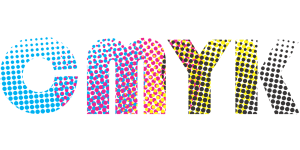The Agony of Colour!
The number one trouble-maker, the most important aspect, the most eye-catching component of every printed product: colour! It is important to get it right. It is so easy to get it wrong. And not many people outside the printing industry know the first thing about it. So let’s see if we can shed some light (he he) on the basics of colour. What is the difference between RGB and CMYK colour modes?
RGB and CMYK
Here are the basics of RGB and CMYK.
RGB
RGB (Red, Green, Blue) is suitable for images for the web, and anything that displays on a monitor or TV. Push your face up against a screen (ye olde CRT TV is best) and you can even see the RGB squares that make up the total picture. Millions of colours can be made up with a particular combination of red, green and blue. RGB files are often more vibrant than their CMYK equivalent, and this is emphasised further when the file is printed. This is because the image will never look as bright on a piece of paper as it odes on a lovely backlit monitor.
CMYK
 CMYK stands for Cyan, Magenta, Yellow and blacK (OK, the black ‘K’ doesn’t quite work, but that is another story…). These are the four different colours that are used in full colour offset printing. CMYK covers 95% of the products that we offer at Printing Brisbane. The printing presses have four ink tanks, each filled with one of these colours, and maybe other tanks filled with other special colours or special effect ‘inks’. If you want to print a file that is in RGB, it will need to be converted to CMYK. It is best to do that before it goes to print so you can see what it looks like on the screen (even though that is no guarantee for the final result). Don’t leave it up to the press to work out, who knows what it will come up with!
CMYK stands for Cyan, Magenta, Yellow and blacK (OK, the black ‘K’ doesn’t quite work, but that is another story…). These are the four different colours that are used in full colour offset printing. CMYK covers 95% of the products that we offer at Printing Brisbane. The printing presses have four ink tanks, each filled with one of these colours, and maybe other tanks filled with other special colours or special effect ‘inks’. If you want to print a file that is in RGB, it will need to be converted to CMYK. It is best to do that before it goes to print so you can see what it looks like on the screen (even though that is no guarantee for the final result). Don’t leave it up to the press to work out, who knows what it will come up with!
Spot Colours
There are some special colours that can’t be created through any combination of CMYK. If you really need to use one of these colours (usually a really vibrant colour) then you need a spot colour. They look great, but they cost more. To get a spot colour, the printer uses a ‘recipe’ to mix the correct colour according to the PMS (Pantone Matching System) number that you have specified. The mixed ink is poured into a tank on the press, and then they are ready to go. This is why it costs more. Then ink has to be mixed especially for your order, the press can only print your order and then has to be cleaned before it can be used for anyone else. It’s a good idea to choose corporate colours that look good in CMYK and in PMS.
Points on RGB and CMYK to remember
In summary, print files never look the same on paper as they do on the screen, or when printed on the laser printer in your office. RGB files need to be converted to CMYK before being printed, or the results may be a little odd. Spot colours are great for something special (or things like envelopes) but stick to CMYK if you aren’t a millionaire. And keep this in mind when you are at the stage of choosing colours to represent your business.







